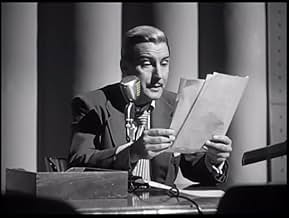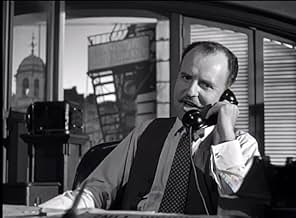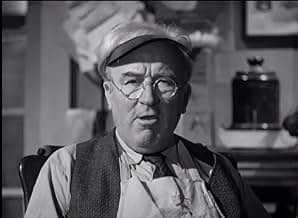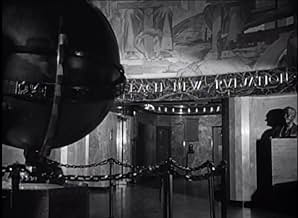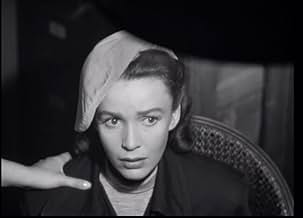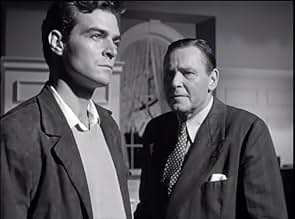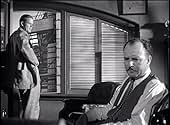IMDb RATING
6.9/10
1.5K
YOUR RATING
The story of the fight of a small-town newspaper to free an innocent girl of a murder charge, with the publisher of a metropolitan city newspaper heading, by forced circumstances, the opposi... Read allThe story of the fight of a small-town newspaper to free an innocent girl of a murder charge, with the publisher of a metropolitan city newspaper heading, by forced circumstances, the opposing forces.The story of the fight of a small-town newspaper to free an innocent girl of a murder charge, with the publisher of a metropolitan city newspaper heading, by forced circumstances, the opposing forces.
- Director
- Writers
- Stars
Howard Da Silva
- Carl Durham
- (as Howard da Silva)
Jay Adler
- Munsey's Assistant
- (uncredited)
- Director
- Writers
- All cast & crew
- Production, box office & more at IMDbPro
Featured reviews
The more I watch classic films, the more I discover what a great year 1950 was in the movie business. Here's another good film, and one many people are probably unfamiliar with. This one revolves around the newspaper business.
Dan Duryea, as usual, is interesting as "Mike Reese," a bad guy-turned-good guy journalist. He is joined in the cast by Herbert Marshall, Gale Storm (one of the great names in show business and who will forever be "My Little Margie" to those of us who were around in the '50s), Howard Da Silva and Michael O'Shea.
Of the above-mentioned, Da Silva was the most fascinating, as the brutal mob boss "Carl Durham." He only had a minor role, but some of his lines were outstanding and his role was memorable. Da Silva was a great actor for film noirs. This isn't really a noir, but it's close. Marshall was just fine as the newspaper owner.
The film was not kind to the newspaper business, so some media-minded film critics (who probably had columns in daily papers) didn't like this film for that reason. Too bad. They should have liked it, since it had Left Wing written all over it, with several Liberal themes and favorite catch-phrases such as "witch hunts" (one of their all-time favorites).
Nonetheless, it's a powerful film and well-acted.
Dan Duryea, as usual, is interesting as "Mike Reese," a bad guy-turned-good guy journalist. He is joined in the cast by Herbert Marshall, Gale Storm (one of the great names in show business and who will forever be "My Little Margie" to those of us who were around in the '50s), Howard Da Silva and Michael O'Shea.
Of the above-mentioned, Da Silva was the most fascinating, as the brutal mob boss "Carl Durham." He only had a minor role, but some of his lines were outstanding and his role was memorable. Da Silva was a great actor for film noirs. This isn't really a noir, but it's close. Marshall was just fine as the newspaper owner.
The film was not kind to the newspaper business, so some media-minded film critics (who probably had columns in daily papers) didn't like this film for that reason. Too bad. They should have liked it, since it had Left Wing written all over it, with several Liberal themes and favorite catch-phrases such as "witch hunts" (one of their all-time favorites).
Nonetheless, it's a powerful film and well-acted.
One might choose to ponder the social messages that this film supposedly contains---witch hunts, HUAC investigations, etc---but I'd recommend that you just sit back and enjoy a terrific, well-plotted and fast-moving film.
Not to ignore any social issues that the film might have intended to address, but you're really spinning yer' wheels over very little if you spend too much time looking for them. True, the innocent black maid is framed for murder (and, indeed, Gar Moore's despicable character even utters the "N" word), but it strikes me as just another compelling element in this very intense drama (and if they wanted to make a big social point, why didn't they hire an actual black actress for the part, I wonder?)
Dan Duryea was born to play the role of Mike Reese; he totally dominates the film, and brilliantly. Gale Storm is pretty and has a nice, simple charm about her, but she's totally out of her league alongside Duryea, Herbert Marshall, Howard da Sylva, and Michael O'Shea.
Speaking of da Sylva's role, several other reviewers have cited his "scenery chewing"; I disagree, and strongly. DaSylva, a first-rate actor, is a model of control: suave, witty, affable...a facade which barely manages to conceal a razor-sharp hostility just beneath the surface. It's a masterful, if fairly brief, performance.
Also, it's fascinating to watch "Underworld Story" and discover why the classic "Night of the Hunter" (1955) looks the way it does. Stanley Cortez's bleak, stylized cinematography adds immensely to the atmosphere of "Underworld", especially the near-expressionistic look of the streets and buildings of the town where most of the action takes place.
"Underworld Story" should be regarded as a stand-out example of classic, late 40-s noir.
Not to ignore any social issues that the film might have intended to address, but you're really spinning yer' wheels over very little if you spend too much time looking for them. True, the innocent black maid is framed for murder (and, indeed, Gar Moore's despicable character even utters the "N" word), but it strikes me as just another compelling element in this very intense drama (and if they wanted to make a big social point, why didn't they hire an actual black actress for the part, I wonder?)
Dan Duryea was born to play the role of Mike Reese; he totally dominates the film, and brilliantly. Gale Storm is pretty and has a nice, simple charm about her, but she's totally out of her league alongside Duryea, Herbert Marshall, Howard da Sylva, and Michael O'Shea.
Speaking of da Sylva's role, several other reviewers have cited his "scenery chewing"; I disagree, and strongly. DaSylva, a first-rate actor, is a model of control: suave, witty, affable...a facade which barely manages to conceal a razor-sharp hostility just beneath the surface. It's a masterful, if fairly brief, performance.
Also, it's fascinating to watch "Underworld Story" and discover why the classic "Night of the Hunter" (1955) looks the way it does. Stanley Cortez's bleak, stylized cinematography adds immensely to the atmosphere of "Underworld", especially the near-expressionistic look of the streets and buildings of the town where most of the action takes place.
"Underworld Story" should be regarded as a stand-out example of classic, late 40-s noir.
Deceptively titled, The Underworld Story boasts only tenuous connections to organized crime. It's a newspaper story that centers around a high-profile murder with racial overtones. But its crusading tone and topical allusions never grow strident and don't overwhelm some adroit plotting and incisive character study.
Big-city reporter Dan Duryea finds himself in a jam that makes him persona non grata to his newspaper, the district attorney's office and underworld boss Howard Da Silva. Broke and blacklisted, he buys himself a partial stake in a struggling community paper, The Lakewood Gazette, owned by Gale Storm, who's put off by his brash ways and temporizing ethics. But a headline story breaks right there in the idyllic New England town: The daughter-in-law of press baron Herbert Marshall has been murdered, and Duryea seizes the chance to run with the scoop.
It's not a whodunit, though; the killer, it's clear from the outset, is Marshall's snivelling son (Gar Moore, who sounds like HAL the computer). But when the murdered woman's black maid (Mary Anderson) goes missing, Marshall sees opportunity to whip up public sentiment against her. Storm, who knew the maid, trusts in her innocence; Duryea, on the other hand, waits to see which outcome might profit him most. When The Gazette starts a defense fund for Anderson, Marshall and his son start running scared and seek a favor from Da Silva to put a stop to the tenacious Duryea, who's been won over by Storm....
The Underworld Story's a modest movie that's well put together (it looks great, too, photographed by Stanley Cortez, who also shot The Magnificent Ambersons and Night of the Hunter). But it belongs to Duryea, who could play affable but slithery better than anybody, and his twists and turns keep us guessing.
Reminiscent of 30s socially-conscious cinema more than film noir, The Underworld Story also shows that decade's story-telling verve. It's been purged of preaching, so when one character remarks `Looks like they're burning witches again,' we suddenly recall that its release came in the midst of the Hollywood anti-Communist witch hunt, and that at least two of its principals director Cy Endfield and Da Silva were among its victims.
Big-city reporter Dan Duryea finds himself in a jam that makes him persona non grata to his newspaper, the district attorney's office and underworld boss Howard Da Silva. Broke and blacklisted, he buys himself a partial stake in a struggling community paper, The Lakewood Gazette, owned by Gale Storm, who's put off by his brash ways and temporizing ethics. But a headline story breaks right there in the idyllic New England town: The daughter-in-law of press baron Herbert Marshall has been murdered, and Duryea seizes the chance to run with the scoop.
It's not a whodunit, though; the killer, it's clear from the outset, is Marshall's snivelling son (Gar Moore, who sounds like HAL the computer). But when the murdered woman's black maid (Mary Anderson) goes missing, Marshall sees opportunity to whip up public sentiment against her. Storm, who knew the maid, trusts in her innocence; Duryea, on the other hand, waits to see which outcome might profit him most. When The Gazette starts a defense fund for Anderson, Marshall and his son start running scared and seek a favor from Da Silva to put a stop to the tenacious Duryea, who's been won over by Storm....
The Underworld Story's a modest movie that's well put together (it looks great, too, photographed by Stanley Cortez, who also shot The Magnificent Ambersons and Night of the Hunter). But it belongs to Duryea, who could play affable but slithery better than anybody, and his twists and turns keep us guessing.
Reminiscent of 30s socially-conscious cinema more than film noir, The Underworld Story also shows that decade's story-telling verve. It's been purged of preaching, so when one character remarks `Looks like they're burning witches again,' we suddenly recall that its release came in the midst of the Hollywood anti-Communist witch hunt, and that at least two of its principals director Cy Endfield and Da Silva were among its victims.
What makes this little crime movie as effective as it is, has something to do with the casting of unconventional Dan Duryea in the lead as the unscrupulous reporter. He's a lot like Willem Dafoe with the way he talks out of the bottom of his mouth - like a ventriloquist's dummy - and I mean that in a good way. Had they cast a more conventional leading man in the part like a Jimmy Stewart, for example, I don't think it would've worked as well, because Duryea really does come across as quite a heel, a low-life. It just isn't clear to the viewer if he should root for him or not, so that when he does undergo a change in character, it comes as a surprise rather than a foregone conclusion.
The movie also provides Howard Da Silva with one of his last roles before he was to be blacklisted for over 10 years. Always good at playing thugs, he's quite colorful and does a lot of scenery chewing as a powerful crime figure.
The script is intelligent and gritty, and the photography is appropriately stark and oppressive.
The movie also provides Howard Da Silva with one of his last roles before he was to be blacklisted for over 10 years. Always good at playing thugs, he's quite colorful and does a lot of scenery chewing as a powerful crime figure.
The script is intelligent and gritty, and the photography is appropriately stark and oppressive.
The sleeve on the VHS release of "Underworld Story" calls it "a powerful indictment of sensationalistic journalism." But this very interesting little "B" film's real "powerful indictment" is against the methods of the House Un-American Activities Committee in its search, during the late 1940's and early 1950's, for Communists and fellow travelers in America, especially in the film industry. "Underworld Story" was filmed just after HUAC's hearings of 1949/50 had ended. It was released (1951, through United Artists)as the first of the Hollywood Ten were going off to prison. Both director Cyril Enfield and screenwriter Henry Blankfort were "named" as Communists and both ended up blacklisted (as was actor Howard DaSilva). "Underworld Story" is not mentioned in the various books on the Hollywood blacklist, probably because it was an indie genre picture and lacked the cachet of a big-budget major studio effort. But, make no mistake, "Underworld Story" is a savage indictment of witch hunts, moral ambivalence and racism. All this would be very dry, but "Underworld Story" - although the story is familiar (cad sees the light) - is well plotted, well written, and well acted.
Did you know
- TriviaThe "N" word is overdubbed with "Negro" on at least two occasions. [Note: this may be a local station's practice; the version shown on TCM contains the uncensored language.]
- GoofsAt the funeral, there is a headstone marked "Robert Elis 1720-1777". After the service, as the mourners are leaving, the same headstone appears in a completely different place.
- Quotes
District Attorney Ralph Munsey: Take it easy, Reese. Things are tough all over. Pretty soon a man won't be able to sell his own mother.
- Alternate versionsThe manufacture-on-demand DVD from Warner Archive Collection has the opening and closing 1992 Warner Bros. Pictures logos.
- ConnectionsReferences Le chant de Bernadette (1943)
- How long is The Underworld Story?Powered by Alexa
Details
- Release date
- Country of origin
- Language
- Also known as
- The Underworld Story
- Filming locations
- Los Angeles City Hall - 200 North Spring Street, Downtown, Los Angeles, California, USA("The Turk" was murdered on the steps of City Hall)
- Production company
- See more company credits at IMDbPro
- Runtime
- 1h 31m(91 min)
- Color
- Aspect ratio
- 1.37 : 1
Contribute to this page
Suggest an edit or add missing content

